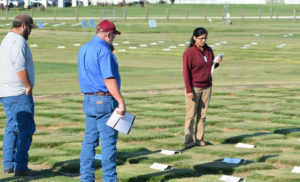Aggie Turfgrass program, field day highlights latest green industry technology
Writer: Kay Ledbetter, 806-677-5608, [email protected]
Contact: Dr. Ben Wherley, 979-845-1591, [email protected]
COLLEGE STATION – Topics ranging from management of sand-capping systems on golf courses to turfgrass cultivars of the future attracted more than 150 people to the Texas A&M Turfgrass and Landscape Field Day on Oct. 11 in College Station.

The event was hosted by the Texas A&M AgriLife Research and Texas A&M AgriLife Extension Service programs within Texas A&M University’s soil and crop sciences department.
Attendees were lawn care operators, golf course superintendents, landscapers, sod producers and professional grounds managers from as far away as Dallas and San Angelo, said Dr. Ben Wherley, associate professor of turfgrass ecology with AgriLife Research and coordinator of the program.
“Attendees gained new information that they will be able to take back and directly apply to improve their turf and landscape management practices,” Wherley said.
“What a great job on a field day that helped showcase new technology to the Texas green industry,” said Dr. Mark Hussey, Texas A&M University System vice chancellor and dean of agriculture. “I’m extremely excited to be here in the new home for the turfgrass science program, the Scott’s Miracle-Gro Center for Lawn and Garden Research. This facility highlights our strong partnership with industry, plus provides an excellent location for us to conduct research, extension and education here at the institution.”
Hussey said all the research, teaching and extension work at the facility is having a great impact on the green industry, not only in Texas but nationally and internationally through the reach of Texas A&M programs.
“These are really exciting times in the green industry and the urban-types of programs within the Texas A&M University System,” he said during the field day luncheon. “We have this great facility where you are able to see some of the research showcased here today. And, at our Dallas location on Coit Road, we are in the process of constructing a new urban research and extension facility that, even by Texas standards, will be best in class.”
Another highlight will be the dedication in the spring of the $10 million project of teaching gardens located on the Texas A&M west campus. Opening of the Leach Teaching Garden will be the beginning of 40 acres of themed spaces for teaching, research and community involvement in The Gardens at Texas A&M University.
“At our Dallas location, our turfgrass breeding program continues to spark lots of innovation in the industry with recent releases of TamStar, or DALSA 0605, a St. Augustine grass with increased levels of drought resistance, and KSUZ 0802, a zoysiagrass with increased levels of cold tolerance,” Hussey said. “We are turning out elite germplasm materials to better serve the industry.”
One of the highlights of the field day and the group at College Station is a new technology known as the Landscape Irrigation Runoff Mitigation System, a collaborative project between Texas A&M Engineering Experiment Station and AgriLife Research faculty. A provisional patent is out on this new technology, which offers a way to do a better job of managing water in landscapes, he said.
“We’ve also developed a new AgriLife Turf Pest Management Guide, which is a comprehensive resource for understanding and selecting herbicides, insecticides and fungicides for use on Texas turf,” Hussey said.
Additionally, he talked about the redeveloped Aggie Turf website, http://aggieturf.tamu.edu, which is intended as a comprehensive site for turfgrass selection and management, as well as providing links to other resources.
“The bottom line is you can see these are exciting times and we have a tremendous amount of momentum here within the Texas A&M University System, all focused on doing a better job of discovering and educating, delivering the latest technology to our state and being a resource to help each of you as you go through your professions,” Hussey said.
Hussey also recognized Kent Potts and his family for their philanthropy in establishing the R.C. Potts Endowment to help support Texas A&M’s research, teaching and extension student opportunities.
“These endowments provide us with that margin of excellence we need in our programs,” he said. “I know the family will appreciate if others step forward and contribute to this endowment going forward. As we think about the Texas turf industry and urban agriculture, it is something that will continue to make a tremendous impact going forward.
“Hundreds, maybe even thousands, of students will tell you the reason they came and the reason they were able to stay at this institution is because of R.C. Potts,” Hussey said.


